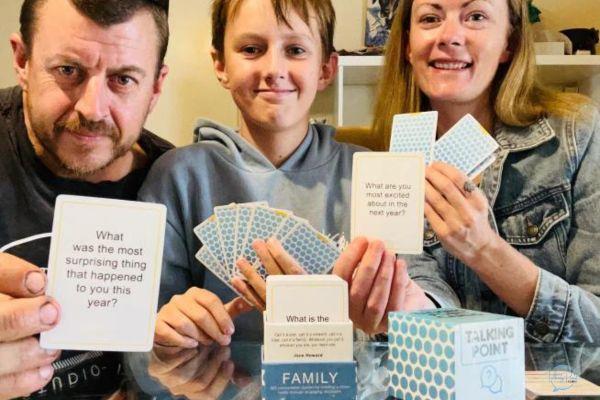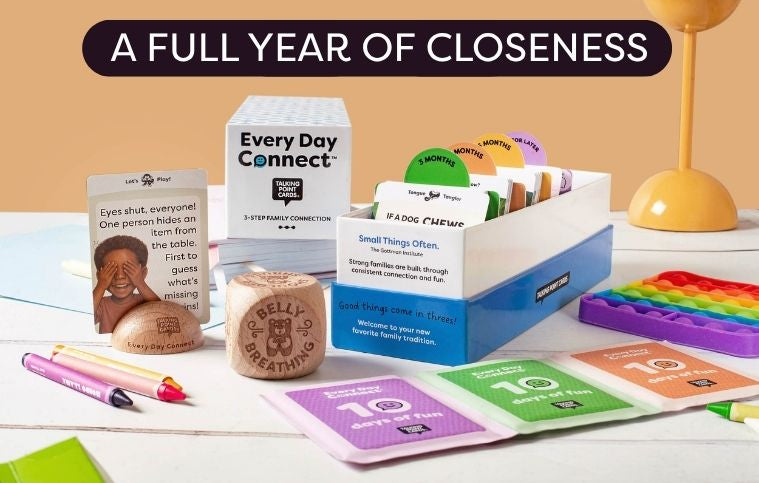SHOP
About
Teaching Kids to Communicate
5 Techniques for Meaningful Conversations

Let's just come out and say it - having meaningful conversations with kids can sometimes make you feel like you're trying to talk to a brick wall. (Minus the satisfying rebound when you kick the wall.)
Their attention span is...well, have you seen a 5-year-old get bored of a new toy within 10 minutes? And if you've ever found yourself droning on and on about why it's important to eat vegetables or brush their teeth, only to realize mid-sentence that their eyes have glazed over, you're certainly not alone.
But here's the thing - good communication skills aren't just a nice-to-have, they're absolutely crucial for your kid's social, emotional, and intellectual development. That's why today, we're going to arm you with 5 killer techniques to turn those one-way lectures into two-way meaningful convos. Strap in.
The Struggle is Real
Before we dive into the techniques, let's take a moment to appreciate just how big of a struggle communicating with kids can really be sometimes. It's easy to default to talking at them instead of with them when you feel that familiar impatience/frustration bubbling up.
They may not be able to express themselves clearly yet, get distracted by every little thing, or just outright refuse to engage. And sometimes, it almost seems easier to just give up and tell them what to do rather than take the time for a real back-and-forth.
Trust me, I get it - I have two nephews and the amount of times I've asked a question only to be met with loud chewing noises or an abrupt change of subject is enough to make anyone's head spin.
But pushing through that temporary discomfort and making room for real conversations? That's where the magic happens. So are you ready to learn how? Let's do this.
Technique 1: Make it a Game 🎲

You know that glazed-over, disinterested look kids get when you're trying to have a serious chat? One of the best ways to snap them out of that funk is to turn your conversation into a game.
For example, you could take turns asking each other "Would you rather..." questions about fun, imaginative scenarios. Not only does this get their mind working, but you'll learn about their preferences and thought process through their answers.
Another idea is to play a round of "Fortunately/Unfortunately" by taking turns making up a story - one person says something fortunate, the next person responds with something unfortunate that happens next, and so on. It's a creative way to practice back-and-forth dialogue.
The key here is making it low-pressure and engaging their sense of playfulness. Games naturally invite participation and keep everyone's interest piqued. So have fun with it!
Tip: Model the mindset that conversations can just be pure, playful fun - not everything has to be an Intense Life Lesson.

Technique 2: Ask Better Questions
If simply asking "How was your day?" typically elicits a one-word response from your kid, you're not alone. For some reason, us grown-ups tend to lean heavily on bland, dead-end questions around kids.
The solution? Ask better, more thought-provoking questions! More specifically:
-
Ask open-ended questions that can't be answered with a simple "yes" or "no"
-
Make your questions specific, visual, and spark their imagination
-
Frame questions around their interests, experiences, and worldview
For example, instead of "Did anything fun happen at school today?", ask something like:
"If you could rename the cafeteria food, what would you call 'Taco Tuesday'? How about 'Chicken Nugget Ninjitsu'?"
Or try: "If you had to pick a new hairstyle for your teacher, what would it look like?"
The more creative and personalized your questions, the more engaged they'll be in answering. And who knows, you may even get some comedy gold out of their responses!
Pro Tip: Open-ended questions keep the conversation flowing in a fun, natural way. Just avoid anything too deep or heavy-handed.
Technique 3: Watch, Mirror, Engage 👩👦

How many times have you asked your kid something only to realize you're the one dominating the conversation?
It's such an easy trap to fall into - we slip into lecture mode without realizing it and suddenly we're talking at them rather than with them. Time to flip the script., engaged listener first. When your child is talking, really watch and listen to them. Mirror their body language, energy levels, and tone. This shows you're truly present and tuned into their vibe.
Then, respond by engaging with what they just said - ask a follow-up question, share a related thought or experience, or playfully riff off their words. The goal is to create an continuous loop of back-and-forth dialogue.
By mirroring and staying in-sync with their communication style first, you keep them engaged and make them feel truly heard. Only then can you steer the chat in a slightly more "meaningful" direction if needed. But always follow their lead.
This is a simple but powerful way to build an atmosphere of mutual exchange, rather than just lecturing. Because at the end of the day, communication is a two-way street!

Technique 4: Keep it Snack-Sized 🍿
Here's a harsh truth - kids generally have a shorter attention span than.......squirrel!
Just kidding. But only slightly. The reality is that lengthy diatribes and heavy conversations are a surefire way to get those little eyes glazing over again.
That's why your messages and chats need to be "snack-sized" - short, focused, and easy to digest. Drop the important points, invite their perspective, then circle back later to build on the discussion organically.
Think of it like serving up bite-sized conversation pieces, rather than trying to force them to chow down on one big, unappetizing word loaf.
For example, instead of launching into a 10-minute lecture about eating enough vegetables, set a 1-minute timer and challenge them to rapid-fire list as many veggies as they can think of. Then build from there:
"Wow, nice list! Which ones are your favorites? Why do you think veggies are so important for our bodies? I'll give you a hint - it keeps your nutrients well-fed so you can grow nice and strong!"
The snack-sized approach keeps things engaging, interactive, and prevents anyone from checking out mentally. Plus, you can always pick up the thread again later!
Micro-Dosing Wisdom: Little nuggets of insight > Lecturing Word Tsunamis
Technique 5: Embrace the "Offroad" Moments

Sometimes, kids will take a left-turn out of nowhere and start talking about something completely off-topic from your intended conversation. Rather than getting flustered or trying to "re-rail" them, embrace those offroad moments!
Those are amazing opportunities to give them your full, undivided attention and actually dive deeper into their interests and learn how their mind works.
For example, if you're chatting about their day at school and they suddenly bring up dinosaurs or ask what happens when you flush the toilet - go with it! Ask engaging follow-up questions and let the conversation veer down that path for a while.
Not only does this show you're listening and value their thoughts, but it models back-and-forth dialogue in a fun, free-flowing way. It's also a prime opportunity to learn something new yourself!
The main thing is not to get too rigid about sticking to your intended talking points. Those can always be revisited later once their interest has been sufficiently stimulated and engaged.
By loosening the reins a bit, you're laying important groundwork for the habit of mutual exchange and curiosity. Which is really the whole point!
Well, there you have it - 5 killer techniques to engage your kids in fun, meaningful conversations that stick. No more blank stares and one-word answers when you're trying to chat!
The main thing to remember is that communication is a two-way exchange. So instead of telling them things, give them opportunities to share their thoughts, use their imagination, and let conversations organically unfold.
Gamify it. Ask better questions. Stay in sync. Keep it bite-sized. And embrace those delightfully offroad detours into their fascinating little minds.
Because at the end of the day, teaching strong communication skills is one of the greatest gifts you can give your child. Not only will it nurture their emotional intelligence and bring you closer together, but it sets them up for a lifetime of meaningful connections and understanding with others.
Who knows, maybe those little dinosaur detours today will turn into them becoming a paleontologist or toilet scientist tomorrow! The key is keeping an open mind, engaging their natural curiosity, and turning every interaction into a portable communication dojo.
So next time your kid starts telling you about their weird dream or going off about their latest weird obsession, don't just smile and nod - join them in that moment. Ask questions, share your own personal anecdotes, and let the conversation ping-pong around organically.
It might feel messy and unfocused at times, but you're creating the sacred spaces for them to find their voice, be truly heard, and develop crucial interpersonal skills. Which are honestly things we could all get a little better at, kids or not.
So keep being patient, playful, and present in those little conversational moments. Not only is it lifelong communication training for them, but who knows - you might even rekindle your own long-dormant sense of childlike wonder and curiosity along the way!
LIKED THIS ARTICLE?
SIGN UP FOR MORE!






